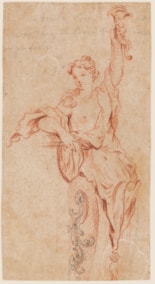François-Antoine VASSÉ
(Toulon 1681 - Paris 1736)
Design for a Decorative Motif: A Partially Draped Young Woman Holding a Sconce Aloft
Sold
Red chalk, with touches of black chalk.
A faint partial inscription in French in pencil at the top.
149 x 79 mm. (5 7/8 x 3 1/8 in.)
ACQUIRED BY THE MUSÉE DES ARTS DECORATIFS, PARIS.
A faint partial inscription in French in pencil at the top.
149 x 79 mm. (5 7/8 x 3 1/8 in.)
ACQUIRED BY THE MUSÉE DES ARTS DECORATIFS, PARIS.
This would appear to be a design for the corner of a fireplace or desk, or perhaps a wall candelabrum.
Although no signed drawings by François-André Vassé are known, an understanding of his draughtsmanship is provided by several drawings reasonably attributed to him, as well as engravings known to be after his designs. Drawings that have been convincingly attributed to Vassé include designs for an altar at Notre Dame of 1711-1712, a chimneypiece for a palace in Madrid, probably executed between 1713 and 1715, and several studies for the walls, ceiling and trophies of the gallery of the Hôtel de Toulouse in Paris of 1718, as well as a design for a clock of c.1734.
Alastair Laing has suggested that this drawing may be the work of François-Antoine Vassé, and is possibly a study for a chimneypiece in the Hôtel de Toulouse in Paris. Formerly the Hôtel de La Vrillière, the Hôtel de Toulouse was remodelled, under the direction of the architect Robert de Cotte, between 1714 and 1719 for Louis-Alexandre de Bourbon, Comte de Toulouse. Vassé is known to have worked extensively at the Hôtel de Toulouse, and is credited with the design of much of the galerie of the building, constructed in 1718.
A somewhat comparable design by Vassé for a wall candelabrum with a faun, in pen and ink, is in the Rijksmuseum in Amsterdam.
Although no signed drawings by François-André Vassé are known, an understanding of his draughtsmanship is provided by several drawings reasonably attributed to him, as well as engravings known to be after his designs. Drawings that have been convincingly attributed to Vassé include designs for an altar at Notre Dame of 1711-1712, a chimneypiece for a palace in Madrid, probably executed between 1713 and 1715, and several studies for the walls, ceiling and trophies of the gallery of the Hôtel de Toulouse in Paris of 1718, as well as a design for a clock of c.1734.
Alastair Laing has suggested that this drawing may be the work of François-Antoine Vassé, and is possibly a study for a chimneypiece in the Hôtel de Toulouse in Paris. Formerly the Hôtel de La Vrillière, the Hôtel de Toulouse was remodelled, under the direction of the architect Robert de Cotte, between 1714 and 1719 for Louis-Alexandre de Bourbon, Comte de Toulouse. Vassé is known to have worked extensively at the Hôtel de Toulouse, and is credited with the design of much of the galerie of the building, constructed in 1718.
A somewhat comparable design by Vassé for a wall candelabrum with a faun, in pen and ink, is in the Rijksmuseum in Amsterdam.
The son and pupil of the sculptor Antoine Vassé, and possibly also of Pierre Puget, François-Antoine Vassé first worked with his father at the Arsenal in his native city of Toulon, the premier French naval port. (This was an experience that eventually gained him an appointment as dessinateur général de la Marine in 1715, with responsibility for the design and decoration of the interiors of the most important ships of the French Navy.) By the turn of the century the young Vassé had settled in Paris, where in the spring of 1707 he won a prize at the Académie Royale. By September of the following year he was working as a decorative sculptor at Versailles, where he was active for several years. Vassé also worked at the Tuileries, the Hôtel de Toulouse and the altar of Notre-Dame. He achieved a position of artistic pre-eminence, alongside the designer Gilles-Marie Oppenord, during the last years of the reign of Louis XIV. In 1723 Vassé was agrée at the Académie Royale.
Provenance
Anonymous sale, London, Sotheby’s, 2 July 1997, lot 222 (as French School, 18th Century)
P. & D. Colnaghi, London
Private collection, Middlesex
Thence by descent.
P. & D. Colnaghi, London
Private collection, Middlesex
Thence by descent.




